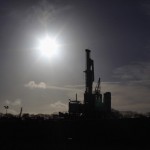There’s Been Hundreds of Small Quakes in North Texas Since December

SMU
From the SMU progress report: “Preliminary earthquakes locations near Reno-Azle using the current seismic network. Events are scaled by magnitude and color coded by time of event. Two Salt Water Disposal Wells (SWD wells) that occur within a few kms of the earthquake sequence are shown.”
North Texas is no longer a place you can expect to live earthquake-free. That’s the big takeaway from a progress report out this week from Southern Methodist University on their study of tremors around the towns of Reno and Azle that began last fall.
“This sequence, with the first felt event [earthquake] occurring in November 2013, follows several other earthquakes sequences of earthquakes occurring in Tarrant and Johnson Counties since 2008,” the report says. A team of scientists from SMU, with help from the U.S. Geological Survey (USGS), installed monitors to better measure the quakes in region.
While the larger quakes have stopped, with the most recent occurring in late January, smaller earthquakes continue, the report says. There’s been hundreds of them large enough to be recorded by multiple monitoring stations since December, with “thousands of very small events during periods of swarm activity.”
And the scientists aren’t sure when they’re going to happen. “Swarms of 100s of events can occur in a day, but weeks with few to no earthquakes have also occurred,” the report says.
What’s behind the quakes? In other parts of Texas, including in nearby Johnson and Tarrant counties, the disposal of wastewater from oil and gas drilling and production has been found to be responsible.
Several peer-reviewed academic studies have shown that in Texas (and other parts of the country), when large volumes of oil and gas wastewater are injected deep underground for disposal, it can cause faults to slip, triggering quakes.
More from the SMU report:
The link between felt earthquakes to waste-water fluid injection points related to shale gas development in Texas and other states remains a major question. Understanding if and/or how injection of fluids into the crust reactivates faults has important implications for seismology, the energy industry, and society.
The study team is developing rock mechanics models to understand fluid flow pathways in complex geology, but model results are not available at this time. The number and diversity of instruments we have deployed in the Reno-Azle area provide an unprecedented opportunity to make progress in this field, especially as since some preliminary earthquake locations are within 1-2 km of SWD [disposal] wells.
The research team at SMU declined to be interviewed, but members are expected to testify Monday at the state legislature, where a House subcommittee will hold its first hearing looking into “increased seismic activity” in Texas and its connection to oil and gas wastewater disposal.
In the progress report, the SMU team says they’re still collecting data on the quakes, “but anticipate providing peer-reviewed results in the future.”
While North Texas has had to deal with swarms of smaller earthquakes, across the Red River the situation is far worse. Quakes in Oklahoma (many of them already linked to oil and gas wastewater disposal wells) have gotten so bad that the USGS and Oklahoma Geological Survey issued a joint statement this week warning serious damage could occur to older buildings because of the quakes.
“The rate of earthquakes in Oklahoma has increased by about 50 percent since October 2013, significantly increasing the chance for a damaging quake in central Oklahoma,” the agency warned this week. Oklahoma has had more earthquakes since October than California. In the six months from October 2013 to mid-April 2014, there were nearly 183 earthquakes measuring 3.0 or stronger in the state.
“A likely contributing factor to the increase in earthquakes is wastewater disposal by injection into deep geologic formations,” the joint statement says.
Here’s the full progress report on the SMU study on the North Texas Reno and Azle quakes:

